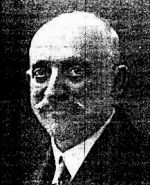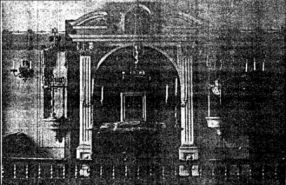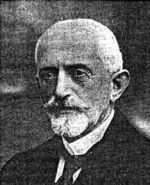
|

|

|
|
|
[Pages 608-610]
(Stod, Czech Republic – 49°38' 13°10')
Prof. Dr. Al. Bergmann, Olmütz
Donated by David W. Bernard
The first mention of the Jews in Staab (Czech: Stod) found in the written documents available to us in the Staab city archive occurs in the first half of the 17th century. Among the municipal invoices in the era following the Thirty Years' War, there is repeated mention of a Jew from Kladrau, probably a tavern owner. A hundred years later, in 1782, one finds on page 12 of the city minutes in the note entitled “Due to the lease of the Cridaric Procopic Tavern of the Gov. Dec.,” the following verbal statement: “At noon on the named day (December 21, 1782), an official ordinance with enclosed gubernatorial order no. 7/12 XII. a. c. arrived, which stated that only Jews shall be permitted to lease (out) the state distillery or another such establishment (Author's note: “if a Jew was living in the community” should be added), thus the suggested lease of an entire bourgeois house with taxable fields on the Staab market to the Merklin Jew Lazar Abraham can hardly be permitted, since there had never been a Jew in that town anyway.”
(Record: “Due to the lease of the Cridaric Prockopic Tavern of the Gov. Dec.”)
In order to be able to understand this obscure language, one must first say that the Chotieschau [today: Chotěšov] authorities, as well as the citizens subject to them, had always been very antiSemitic, or at least unfavorably disposed to Jews. The Jews, who were interested above all in acquiring the profitable taverns, were excluded from leasing, however, by the cited official order. According to tradition, the citizens of the subordinate city of Dobrzan were the most antiSemitic, which was expressed in numerous expulsions of Jews. Schaller, as well as Sommer (1838), mentions that only one Jewish family was allowed by the authorities to settle in the entire Chotieschau domain (Sommer, p. 106, The Pils District). In the surrounding area, on the other hand, larger groups of dispersed Jews settled on small estates, whose owners viewed the Jews as welcome taxpayers, in order to increase their incomes that were mainly derived from the poor and fluctuating income from agriculture. Staab's most interesting neighboring community that had Jewish families was certainly Nedraschitz, which was located two hours away. Schaller does not mention this Jewish community in Nedraschitz, but Sommer cites it (p. 122, Pils District); in Nedraschitz there were eleven Jewish families, a large number of which has migrated, but whose house of prayer has been preserved and is still being used. One house still remains that has an interesting construction and was previously inhabited by Jews. Its style corresponds to the one commonly found in the Pils district and may well date from the end of the 17th century (see above).
In the environs of Staab, there were also old Jews in the communities of Merklin, Kladrau, Dölitschen, Piwana (here, according to Sommer (1838), there were still seven Jewish houses with ten Jewish families), then in Mies, in the town of Tuschkau, and in Nürschan. The Jews of the united municipality of RakolusRajowa and Dollana in the Mies Valley finally constituted the basis of the Jewish community that developed in Staab after the year 1848. Around the time mentioned, Jews began to migrate to Staab from the Mies and Tuschkau regions. Their primary occupation was peddling. Frugal and successful in business, they became within half a century the most important economic factor of the city of Staab.
Preserved for us in the city archive of Staab are three documents dating from the time of the immigration and (the city's) founding, which should probably be quoted verbatim, in order to illuminate the situation and show under which conditions and from which locations the community's Jews came. It concerns official documents, character references.
The first one says:
| Stamp 15 Czech. crowns | |
| Reference |
The mayor of Rakolus and Dollana hereby certifies that Jele Bernard of Rakolus has demonstrated honest and upright behavior throughout all the years he has lived in our community. Therefore he can be granted the very highest character reference.
| Rakolus and Dollana, January 22, 1857 | ||
| sieben | ||
| .. Laurenz Stengl | ||
| Mayor | ||
| (City seal) | ||
The second:
| 15 Czech crowns | |
| Reference |
The mayor of Rakolus and Dollana hereby certifies that Abraham Bernard of Rakolus has demonstrated honest and upright behavior throughout all the years he has lived in our community. Therefore he can be granted the very highest character reference.
| Rakolus and Dollana, January 22, 1857 | ||
| sieben | ||
| .. Laurenz Stengl | ||
| Mayor | ||
| (City seal) | ||
A record with the following wording accompanies both of these documents:
| Abraham Bernard from Rakolus, resident in Staab, petitions for a new peddler?s permit. The aforementioned action recorded in the peddler book was officially submitted to this office on January 16 e.f. N.C. 194.
K.K. Staab District Office |
The character references from the other community, which were submitted during the week following the petition for the peddler's permit, indicate that the Bernard family must have been living in Staab for only a short period of time.
Four years later, Josef Witt, whose descendents, like those of Bernard, now live in Staab and are peddlers from the village of Rakolus, was also issued a character reference, in which Witt is described as loyal, industrious, peaceful, and respecting of authorities. The “Witt” house in Staab is today called “at Samrl”, and the Bernard house, “at Jele(r)”. The tombstone of “Samerl” Witt is one of the oldest in Staab's cemetery and is preserved in the Hebrew script, while the other stones (with the exception of two) are modern and decorated with Latin letters. These three old stones may have been brought from another old cemetery (earlier, the Jews from Staab were buried in Piwana).
|
|
|
|||||
After 1848, the Salz family and the Gutfreund family, which had already migrated, also came to Staab.
As previously mentioned, the Jews of Staab buried their dead in Piwana and in other localities having Jewish cemeteries, if they originated from these villages. Since 1906, the Jewish community of Staab has had a modern, wellkept cemetery, located on Staab Street in the direction of Holeisch, not far from the Christian cemetery. The Salz family in particular rendered great service in acquiring this cemetery, as well as organizing the Staab Jews in general. Thus the early chairmen/head of the K.G., which was organized in 1873, came from the Salz family (Herrmann Salz, Heinrich Salz, 1900 to 1920). Presently, the head of the community is Mr. Josef Salz, industrialist in Staab (since 1920).
These K.V. did a great service by building a dignified temple, by appointing Rlg. [religious leaders?], and by giving the Jewish community a modern organization. Mr. Wilhelm Salz should be considered the true founder of the cemetery. His labor is also responsible for creating a charity organization. He also founded the Ch.K. and is its representative. Other important personalities of the Salz family should be mentioned: Mr. Joachim Salz, the founder of the first Bohemian malt factory; then Dr. phil. Arthur Salz, an outstanding national economist, professor at the University of Heidelberg (as author of various recognized scientific publications on economics); Mr. Wilhelm Salz, founder of the Salz Brickworks, which was developed by Mr. Ludwig Salz into the largest and most modern brick factory in Bohemia; and Messrs. Josef and Oskar Salz, who currently represent the regional malt industry.
In 1930, the number of Jews belonging to the Staab K.G. was 130, 28 of whom were taxpayers. Income and expenses amounted annually to more than 12,000 Kc. With the exception of the city of Nürschan and a few lesser municipalities, the Ger. [German?] district of Staab and Dobrzan belonged to the temple community.
After only one temple had been available to a Jewish B.V. [religious association?] since the year 1862, a synagogue could be acquired in 1882. The undecorated, twostory building had a dignified prayer room on the first floor (in addition to a second smaller one). We are grateful to Rabbi Bussgang for showing us the synagogue and giving us some important information.
|
|
There were few items of importance as far as art history was concerned. Apart from a few beautiful, hammered brass sconces, one finds nothing of this nature in the temple. The heavy red and gold embroidered Tora curtain is from Liblin (close to Radnitz) and was given by the Salz family in 1884. On the other hand, more important memorials are kept in a small niche in the corridor of the ground floor: A small Tora cover made from the bridal dress of Ms. Resl Salz, a threadbare Tora curtain made of blue silk, which a certain Scholom and his wife Marie gave in 1804. Wehlisch is given as the location. Then there are two Tora pointers carved from bone.
The leaders of the K.G. in Staab are then: The aforementioned Mr. Josef Salz, industrialist in Staab (since 1920), as chairman; Mr. Albert Bernard (wholesale merchant in Staab), as vicechairman or representative of the chairman; Mr. Emil Rabl (wholesale merchant in Staab), who has functioned as treasurer since 1929; and Mr. Moritz Bussgang, who, as an educated rabbi, has assisted the K.G. since 1910. Regrettably, Rabbi M. Bussgang left the city of Staab on January 1st. We take the liberty here of mentioning that Rabbi M. Bussgang, who is highly knowledgeable in Near Eastern scripts and languages, is unfortunately one of those academics whose unhappy circumstances closed the doors to further advancement. Predecessors were: Rabbi Salomon Fantl (30 years of service) and Siegmund Beinkelles (3 years of service).
The birth, marriage, and death records of the temple community of Staab were kept by the Catholic priest's office up to 1887 and are still in the possession of the priest's office, which repeatedly causes difficulties and complications. Beginning in 1887, the community kept its own registries.
Finally, we remember the Jews who died during the World War: According to the war memorial in Staab, Artur Löwy, Ernst Schleissner, and Arnold Salz, who were all from Staab, were killed during the war.
That is more or less everything there is to say about the history of the Jews from Staab. Although it does not cover an entire century, it is a segment that tells of enormous advancement. During this time, especially the Salz family became an economic power that, by means of targeted goals, owns the major (significant) parts of the industrial plants of the city of Staab.
Abbreviations used:
- K.K. = “KaiserlichKöniglich” = “Imperial and Royal”, pertained to the Dual Monarchy of Austro-Hungary.]
- K.G. = Kultusgemeinde = Jewish cultural community
- K.V. = Kultusvorstand [?] = community leaders
- Ch.K = Chevra Kadsha = burial society [in Hebrew]
Bibliographical References:
This "History of the Jews in Staab" [Gestichte der Juden in Staab] was extracted and translated from Die Juden und Judengemeinden Bohmens in Vergenheit und Genenwart [The Jews and Jewish Communities in Bohemia Past and Present] in German and Czech; compiled by Hugo Gold, published in Prague 1934.
- SOMMER, Johann Gottfried: Das Konigreich Bohmen; Statstische topographisch dargestellt; Prag; J.G. Calve, 18331849. 16 Vols. [No. 6 Pilsner Kreis 1838]
- SCHALLER, Jaroslaus: Topographie des Konigreich Bohmen, PragWien; W. Piskaczek, 17851797 [No. 9 Theil Pilsner Kreis]
|
|
JewishGen, Inc. makes no representations regarding the accuracy of
the translation. The reader may wish to refer to the original material
for verification.
JewishGen is not responsible for inaccuracies or omissions in the original work and cannot rewrite or edit the text to correct inaccuracies and/or omissions.
Our mission is to produce a translation of the original work and we cannot verify the accuracy of statements or alter facts cited.
 Jews and Jewish Communities of Bohemia in the past & present
Jews and Jewish Communities of Bohemia in the past & present
 Yizkor Book Project
Yizkor Book Project
 JewishGen Home Page
JewishGen Home Page
Copyright © 1999-2024 by JewishGen, Inc.
Updated 12 Jan 2016 by WSB